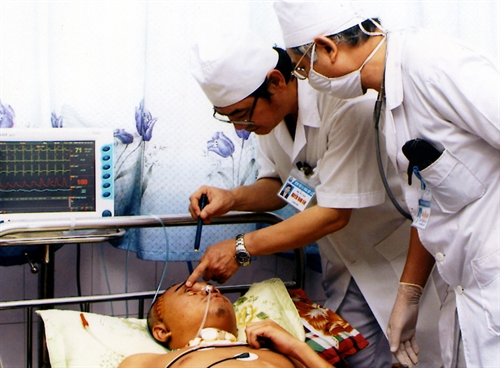 Society
Society

Private hospitals are struggling to receive patients, with most of them operating at 40-50 per cent of their capacity, according to the Việt Nam Private Hospital Association.
 |
| Doctors at Hợp Lực General Hospital, a private hospital in Thanh Hóa Province examine a patient using high-tech equipment. The Việt Nam Private Hospital Association estimates that only one-third of nearly 180 private hospitals across the country make profits while the rest reported losses and are threatened with closure. –VNA/VNS Photo Hữu Oai |
HCM CITY— Private hospitals are struggling to receive patients, with most of them operating at 40-50 per cent of their capacity, according to the Việt Nam Private Hospital Association.
Many private establishments with investment costs of thousands of billions of đồng are on the edge of bankruptcy, said Nguyễn Văn Đệ, chairman of the association.
Most incentive policies are intended for public hospitals, not for private hospitals, Đệ said.
For example, public hospitals are eligible for ODA funds with the Government acting as a guarantee, but private hospitals have to take out commercial loans at high interest rates.
Most private hospitals were established after 2000 and have yet to build a good reputation compared to public hospitals that have existed for dozens of years, the association said.
Some private hospitals said that capital shortage was one of the major difficulties faced by private hospitals.
Most private hospitals have fewer than 100 beds while hospitals with 100-beds and above are only eligible for low-interest loans.
Construction of new hospitals is not allowed downtown, which makes it difficult for them to attract affluent patients who must travel to the city’s outskirts.
Lack of qualified physicians is also a major obstacle facing private hospitals, said Phạm Thế Đồng, deputy head of the Việt Nam Private Hospital Association.
Most medical officials at private hospitals are retired doctors or new medical graduates, Đồng said.
Retired doctors are experience but some are not in good health, while fresh medical graduates lack clinical experience, he said.
Young qualified doctors often choose to work for public hospitals to get more clinical experience and opportunities to study abroad, said Cao Độc Lập, director of Hồng Ngọc private hospital in Hà Nội.
Very few private hospitals can afford to send doctors to study abroad, Lập said, adding that there were few opportunities to get clinical experience at private hospitals.
Lương Ngọc Khuê, head of the Department of Health Examination and Treatment under the Ministry of Health said that the department was considering measures to use qualified medical officials at public hospitals.
Doctors at public hospitals might be allowed to work overtime at private hospitals, Khuê said.
Public and private medical establishments could sign cooperation contracts to send doctors to work at private establishments on fixed days of the week, he said.
The high prices at private hospitals has also made it more difficult to attract patients.
Medical costs at private hospitals are not covered by health insurance. Insured patients have co-payments higher than those at central public hospitals.
As of 2015, the Việt Nam Social Insurance Agency had signed contracts with 150 private hospitals and 167 private clinics, with a total of 3 million health insurance cards registered, said Lê Văn Phúc, deputy head of the Department for Health Insurance Policy Implementation under the Việt Nam Social Insurance Agency.
Thie is much lower than the total of 64 million health insurance cards registered at public medical facilities, Phúc said.
In addition, public hospitals always transfer patients to specialised public hospitals for treatment, even if many private hospitals have high medical qualification, he added.
“There has been significant growth in the number of private hospitals in the last 15 years since the Government allowed private investment in the health sector,” said Nguyễn Đình Khương, deputy general director of Việt Nam Social Insurance Agency.
Private investors have to date injected around VNĐ 4.5-5 trillion (US$200.9-223.2 million) into the domestic health sector, Khương said.
However, they have only contributed around 15 per cent of the total hospital beds.Consequently, the number of overall patients received by private hospitals accounted for only 6-7 per cent, he said.
Meanwhile, public hospitals are running over capacity at almost 170 per cent bed-occupancy, according to the Ministry of Health. —VNS




